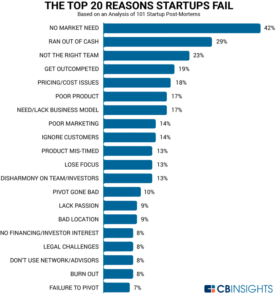How Startups Can Create Minimum Viable Traction
November 21, 2017
PUBLISHED BY Vala Afshar
SOURCE Huffington Post
The top five reasons startups fail are: 1. no market need, 2. ran out of cash, 3. not the right team, 4. get out-competed and 5. pricing or cost issues – this according to a postmortem analysis of 101 startups. One notable reason missing from the list is the ability for startups to gain traction. To learn more about startup critical success factors, Ray Wang, founder and CEO of Constellation Research, and I invited a brilliant venture capitalists with a proven track record in early stage investments in unicorn startups with multi-billion dollar exits to our weekly show DisrupTV.

Bruce Cleveland is a Founding Partner at Wildcat Venture Partners where he focuses on investments in artificial intelligence (AI) marketing, EdTech, enterprise software as a service (SaaS) and the Internet of Things (IoT). His specific areas of interest include enterprise automation, education and training, and general business applications. Cleveland works with early stage companies that use technology and data to increase revenue and decrease costs.
Cleveland is interested in growing entrepreneurial hubs outside of Silicon Valley, with a particular focus on the Pacific Northwest. Cleveland also is committed to sharing his knowledge and experience through the Traction Gap Framework™, which helps entrepreneurs navigate the critical go-to-market period between initial product release (IPR) and reaching minimal viable traction (MVT). Cleveland held senior executive roles in engineering, product management and product marketing with companies, such as Apple, AT&T, Oracle and Siebel Systems. Cleveland began his venture capital career at InterWest Partners, where he was the first investor and a former board member of Marketo, which held an IPO in 2013 and was acquired by Vista Equity Partners in 2016 for $1.8 billion.
Here are the key takeaways from our conversation with Bruce Cleveland:
The 21st Century Wildcatters Are Technologists
Cleveland provided us with a historic perspective in terms of the next generation of wildcatters. In the twentieth century, land and oil drove the industrial age and created tremendous wealth for the early wildcatters of that century. In the 21st century, the wildcatters are technologist in the first intelligence age. These technologist are developing systems of intelligence that enable other companies and consumers to prospect, refine and monetize digital oil, or data. Cleveland invests in companies that focus on capitalization and monetization of data – like Facebook, Amazon, Alibaba. In the first intelligence age, companies that focus on macro digitization are focus areas for Wildcat Venture Partners.
The Traction Gap Framework
80-90% of all startups fail in terms of returning capital, according to Cleveland. Cleveland used 10 years of investing expertise to develop a new framework for ensuring startup success. Cleveland began describing the traction gap framework using a historic perspective. As an entrepreneur and venture investor, Cleveland saw many startups successfully go from an idea to product (the go-to-product phase), from product to traction (the go-to-market phase), and from traction to scale (the go-to-scale phase). Yet time and again, too many companies falter in the middle, go-to-market phase, exposing themselves to lower valuations, significant financing risks, and sub-optimal outcomes.
Cleveland referenced the work by Steve Blank, and the Lean Startup initiative, led by Eric Ries, in terms of their incredible value helping early-stage startups through the go-to-product phase. Cleveland also referenced the Chasm, developed by author Geoffrey Moore, as a framework used by later-stage startups to successfully advance through the go-to-scale phase. The missing piece for Cleveland was what occurs between an early-stage idea and a company that is scaling. Cleveland notes that too often companies stumble in the middle, go-to-market phase, as they fail to generate sufficient momentum to attract new customers or users, and, as a result, investors. This is what Wildcat Ventures calls the Traction Gap™, and Cleveland his team have developed a framework to better equip entrepreneurs during this critical phase.
Read the full article on Huffington Post here.
KEYWORDS